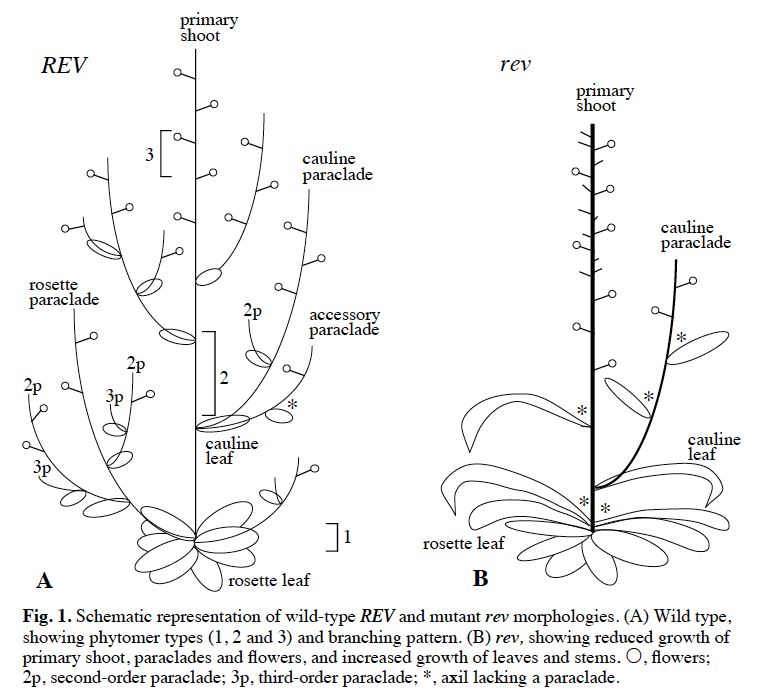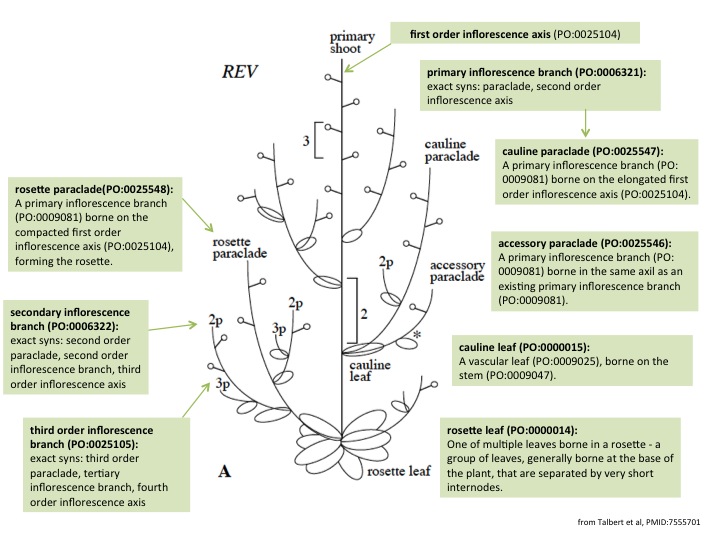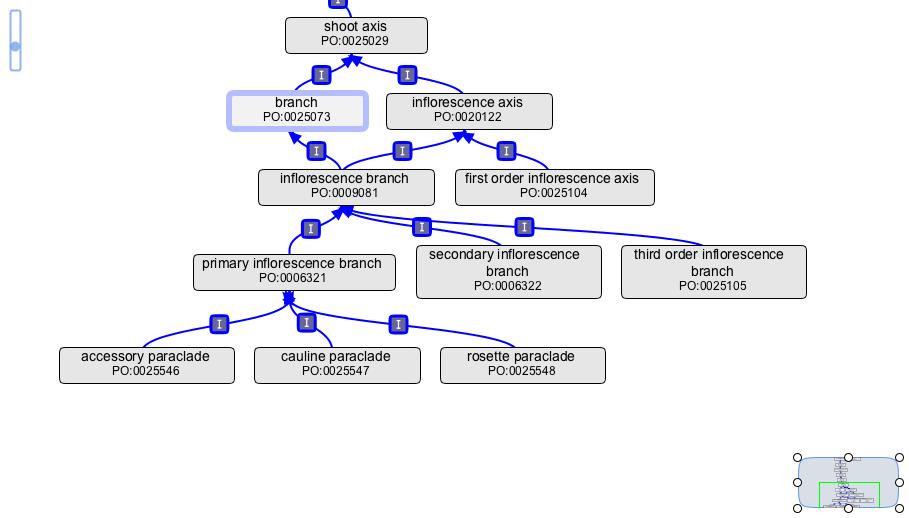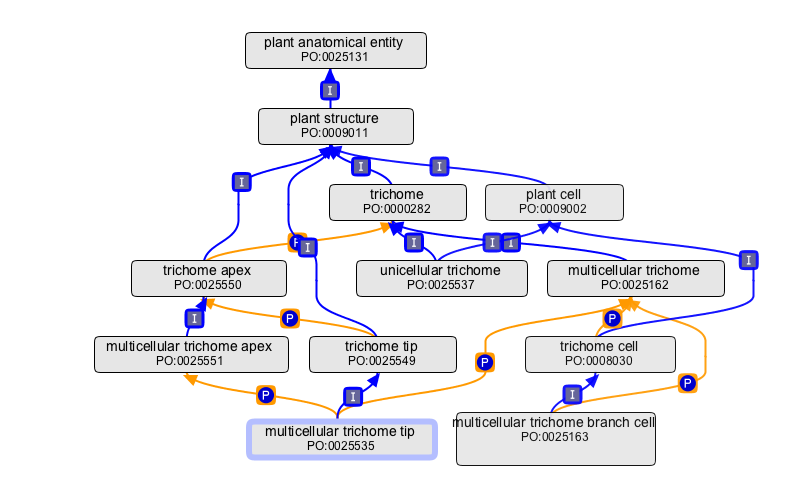POC Conf. Call 4-16-13
POC meeting, Webex Conference Call; Date: Tuesday April 16th, 2013 10am PST/1pm EST
In attendance:Laurel Cooper (OSU), Pankaj Jaiswal (OSU), Barry Smith (University at Buffalo, NY), Justin Preece (OSU), Justin Elser (OSU), Marie Alejandra Gandolfo (Cornell)
Absent: Dennis W Stevenson (NYBG)
accessory branch or accessaory paraclade
Request from JL for the Plant Phenotype project for the term 'accessory branch' or accessory paraclade:
Suggested term and def'n: accessory branch (new PO:ID): A shoot axis (PO:00025029) that develops from a shoot node (PO:0005004) that has produced at least one axillary branch (PO:0006343)
Literature citation: The term 'accessory branch' is used in the description of the different types of phytomers (pg. 2724, top of left column):
"...In both of these phytomer types, a second branch (accessory branch) may later develop between the axillary branch and its subtending leaf (Fig. 1A)." Talbert et al, 1995
This figure is actually referring to an accessory paraclade, not simply an accessory branch.
We have the term paraclade, but it needs to be refined:
Current def'n: paraclade (PO:0004720)- An inflorescence branch (PO:0009081) that ends in an inflorescence that repeats the main inflorescence.
Question: are they both from the same axillary bud meristem (PO:0000232)or is there more than one bud?
Comments: from SF: DWS: Accessory bud is the term used when more than one axillary bud occurs at a node as in many cacti and legumes.
Need to differentiate between the accessory paraclade in the rosette and cauline positions
The term paraclade will be made obsolete and made an exact synonym of inflorescence branch (PO:0009081), since they mean the same thing.
inflorescence branch (PO:0009081): An inflorescence axis (PO:0020122) that is a branch forming from a primary or higher order inflorescence axis.
see this paper for additional information
http://aob.oxfordjournals.org/content/early/2011/03/01/aob.mcr039.full
accessary paraclade etc
Request from JL for the Plant Phenotype project for the term 'accessory branch' or accessory paraclade:
Suggested term and def'n: accessory branch (new PO:ID): A shoot axis (PO:00025029) that develops from a shoot node (PO:0005004) that has produced at least one axillary branch (PO:0006343)
Literature citation: The term 'accessory branch' is used in the description of the different types of phytomers (pg. 2724, top of left column):
"...In both of these phytomer types, a second branch (accessory branch) may later develop between the axillary branch and its subtending leaf (Fig. 1A)." Talbert et al, 1995
This figure is actually referring to an accessory paraclade, not simply an accessory branch.
We had an extensive discussion last week, so to help clarify things I took the figure from last week and labelled it with the new terms
Annotated figure:
branch
branch (PO:0025073): revised definition: A shoot axis (PO:00025029) that develops from an axillary bud meristem (PO:0000232) or from equal divisions of a meristematic apical cell (PO:0030007).
revised comment: In vascular plants, branches arise from an axillary bud meristem (PO:0000232) and from divisions of the meristematic apical cell (PO:0030007) in non-vascular plants.
Changes that were made to the inflorescence branch terms
* primary inflorescence branch (PO:0006321): An inflorescence branch (PO:0009081) arising from a first order inflorescence axis (PO:0025104). was 'second order inflorescence axis' - swapped name and exact synonym and removed the related synonym: second order inflorescence branch as it was inconsistent.
* second order inflorescence branch (PO:0006322)- An inflorescence branch (PO:0009081) arising from a primary inflorescence branch (PO:0006321). (was third order inflorescence axis). Added exact synonyms: second order paraclade, secondary inflorescence branch, third order inflorescence axis, Removed the related synonym: second order inflorescence branch as it was inconsistent.
* third order inflorescence branch (PO:0025105): An inflorescence branch (PO:0009081) arising from a secondary inflorescence branch (PO:0006322). (was fourth order third order inflorescence axis (PO:0025105).
Added exact synonyms: third order paraclade, third order inflorescence branch, fourth order inflorescence axis, tertiary inflorescence branch
Please see https://sourceforge.net/tracker/index.php?func=detail&aid=3609161&group_id=76834&atid=835555 for details about the paraclade terms
see this paper for additional information http://aob.oxfordjournals.org/content/early/2011/03/01/aob.mcr039.full
trichome tip
The problem with this is that sometimes a trichome is unicellular and sometimes it is multicellular. Direct child of plant structure. Part of a trichome is not a cardinal organ part.
multicellular trichome (PO:0025162) A portion of plant tissue that forms a non-sclerified outgrowth from the epidermis. [source: POC:curators]
So the tip would be a portion of plant tissue
multicellular trichome tip (new): A portion of plant tissue (PO:0009007) that is the apical most portion of a multicellular trichome (PO:0025162).
part_of multicellular trichome
Decided to make new term: unicellular trichome, rather than having it a synonym of trichome cell. The we will make general terms trichome tip and trichome apex to be the parents of the parts of the multicellular trichome. Will request the parts of the unicellular trichome from GO.
Made new term:
- trichome apex (new PO:0025550): A plant structure (PO:0009011) that is the apical most portion of a trichome (PO:0000282).
comment: An apex of a unicellular trichome is a GO sub-cellular component GO:xxxxxxx. Will be requested from GO. Added dbxref to OBO_SF_PO:3610120 is_a plant structure, part_of trichome
- multicellular trichome apex (new PO:0025551): A portion of plant tissue (PO:0009007) that is the apical most portion of a multicellular trichome (PO:0025162). added exact synonym: apex of a multicellular trichome; Added dbxref to OBO_SF_PO:3610120
is_a trichome apex, part_of multicellular trichome (PO:0025551)
- trichome tip (new PO:0025549): A plant structure (PO:0009011) that is the apical most portion of trichome apex (PO:0025550).
is_a plant structure, part of trichome apex. Comment: A tip of a unicellular trichome is a GO cellular component GO:xxxxxxx. Will be requested from GO. Added dbxref to OBO_SF_PO:3610120, added exact synonym: tip of a multicellular trichome
- Made multicellular trichome tip (PO:0025535) is_a trichome tip and is_a A portion of plant tissue (PO:0009007). part_of multicellular trichome (PO:0025551), Added dbxref to OBO_SF_PO:3610120
New GO terms:
- unicellular trichome apex GO:0090552: "A cell projection part that is the apical most portion of a unicellular trichome." [GOC:PO_curators, PO:0025537]; is_a: GO:0044463 ! cell projection part
- unicellular trichome tip GO:0090553: "A cell projection part that is the apical most portion of a unicellular trichome apex." [GOC:PO_curators]; relationship: part_of GO:0090552 ! unicellular trichome apex
See the GO tracker for these terms.
Done, This results in adding two new terms as direct children of plant structure; plus muticellular trichome (is_a portion of plant tissue) and unicellular trichome have dual parentage. Not ideal. see tracker for details
Upcoming meetings and Presentations 2013:
NCBO Hackathon April 29-30, 2013
The NCBO Hackathon will take place at Stanford University on April 29-30, 2013. This event will focus on projects in biomedical or clinical informatics that can benefit from use of ontology-based technology.
The entire NCBO Team will be available to brainstorm application ideas and to answer development questions. We will also have separate sessions to provide training on the NCBO Web services, the BioPortal SPARQL endpoint, and other topics of interest requested by participants.
If you are thinking of incorporating semantics into your software application, the Hackathon will provide a great opportunity to get a head start on your project.
Phenotype RCN Plant Group Meeting- Ames, Iowa April 30th-May 3rd
We will be meeting to work on the Plant Phenotype Pilot Project, LC is going
PR-PO-GO meeting, May 15-16th 2013
Please see this page for more information: PRO-PO-GO_Meeting
Location: Buffalo, NY
Dates: May 15-16th, 2013.
- 1. To inform members of the Protein, Plant, Gene Ontology communities of developments in each of these ontologies, and in related ontologies such as the CL (Cell), TO (Plant Trait), ENVO (Environment), PATO (Phenotype) and IDO-Plant (Plant Infectious Disease) ontologies. Specifically:
- a. To enhance the PO treatment of plant-related proteins
- b. To address issues concerning reuse of GO terms to describe plant-related proteins, for example as concerns treatment of plant life cycle and development stages
- 2. To contribute to the cROP (Common Reference Ontologies for Plants) initiative
- 3. To contribute to the ontological understanding of phenotype and disease in all model organisms.
- 4. To identify potentially fruitful applications which enhanced ontology coordination might bring.
1st International Workshop on Semantics for Biodiversity (S4BIODIV), Montpellier, 26-30 May 2013
Registration Information ESWC 2013
Early Registration deadline March 17th
Agropolis Montpellier, the University of Montpellier and Bioversity are collaborating to organize a one-day workshop entitled 'Agrobiodiversity semantics' as part of the larger conference.
Held in parallel with the 10th Extended Semantic Web Conference (ESWC 2013)
Workshop date: May 27, 2013
IMPORTANT DATES:
- Pre-submission inquiry deadline: February 24, 2013 (Abstract up to 500 words)
- Submission Deadline: March 4, 2013
- Notification: April 1, 2013
- Camera ready: April 15, 2013
Note: May be able to send abstract on March 11th and then the final paper by April 15th
TOPICS:
Scientific themes of interest (include but are not limited to):
- sustainable agriculture
- plant
- health and habitat
- relationship between plant-pests/pathogens
- usages of plants by community
- biodiversity conservation
- ecosystems services
- quality of biodiversity data
Informatics technologies of interest (include but are not limited to):
- ontology applications
- knowledge engineering
- linked biodiversity data
- remote sensors
- mobile devices
- vizualization tools
- data mining
MONOCOTS V Meeting at NYBG, July 5th - 14th, 2013
5th International Conference on Comparative Biology of Monocotyledons Friday, July 05, 2013 7:00 AM - Sunday, July 14, 2013 12:00 PM (Eastern Time)
The New York Botanical Garden & Fordham University
ICBO 2013, Concordia University, Montreal, Quebec July 7th - 9th 2013
4th International Conference on Biomedical Ontologies 2013 (ICBO2013)
Concordia University, Montreal, Quebec, July 7th - 9th 2013 call for papers
The conference aim is to foster discussion, exchange, and innovation in research and development in the areas Biomedical Ontology. Researchers and professionals from biology, medicine, computer science and engineering are invited to share their knowledge and experience.
The event is part of the Semantic Trilogy 2013 featuring:
- International Conference on Biomedical Ontologies (ICBO 2013)
- Canadian Semantic Web Symposium (CSWS 2013)
- Data Integration in the Life Sciences (DILS 2013)
Workshop on Semantic Systems Biology 2013 (SSB2013) will be held as part of the International Conference on Biomedical Ontologies (ICBO2013) at Concordia University, Montreal, Quebec, on July 7th, 2013. The event is part of the Semantic Trilogy 2013 (above)
Topics of interest include, but are not limited to:
- ontologies & terminologies for modeling computational biology
- ontologies & terminologies for simulation (and result data) in computational biology/medicine/neuroscience
- semantic web technologies for description, integration, query and discovery of models, simulations and result data
- semantic web technologies for biological data and analysis
- semantic annotations of bio-models
- applications of ontologies in computational systems biology/medicine/neuroscience
- semantic platforms for undertaking and visualizing simulation results
We welcome four types of submissions:
- short papers, up to 4 pages.
- long papers, up to 7 pages.
- position papers, up to 1 page.
- late breaking reports, up to 1 page.
See the ICBO website for further information on the submission types.
All submission are due on Monday, April 15 2013. Notification of acceptance: May 6th, 2013
Botanical Society Meeting July 27-31st New Orleans
- MAG is planning to present the work she has been doing with the images and slides, will circulate the abstract



